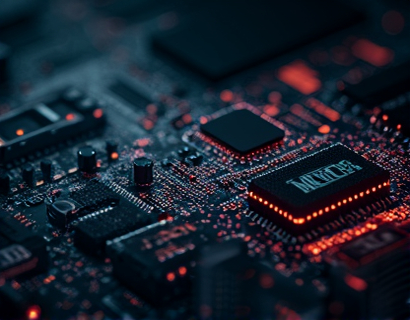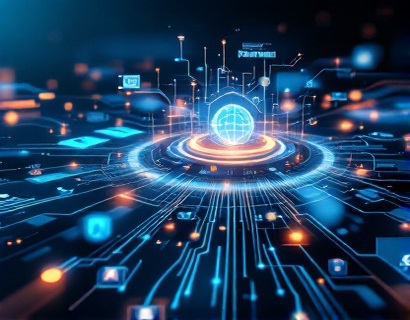Next-Gen Smart Contract AMMs: Unlocking Optimal DeFi Trading and Liquidity Management
The decentralized finance (DeFi) landscape is rapidly evolving, and at the forefront of this transformation are automated market makers (AMMs) powered by next-generation smart contracts. These innovative technologies are revolutionizing how crypto traders and DeFi enthusiasts interact with digital assets, providing enhanced liquidity management and automated trading strategies. In this article, we will explore the intricacies of smart contract AMMs, their benefits, and how they are shaping the future of decentralized trading.
Understanding Automated Market Makers
Automated market makers are a fundamental component of decentralized exchanges (DEXs). Unlike traditional exchanges that rely on order books and market makers to facilitate trades, AMMs use algorithms to price assets and provide liquidity. This allows users to trade directly from their wallets without the need for intermediaries. The core principle behind AMMs is the use of liquidity pools, where users can deposit their assets in exchange for liquidity provider (LP) tokens, which represent their share of the pool.
The Role of Smart Contracts in AMMs
Smart contracts are self-executing contracts with the terms of the agreement directly written into code. In the context of AMMs, smart contracts automate the entire trading process, from pricing to execution. This automation not only enhances efficiency but also reduces the risk of human error. Smart contracts ensure that trades are executed according to predefined rules, providing a transparent and trustless environment for users.
Benefits of Next-Gen Smart Contract AMMs
1. Enhanced Liquidity Management
One of the primary advantages of next-gen smart contract AMMs is their ability to optimize liquidity management. By utilizing advanced algorithms, these AMMs can dynamically adjust liquidity based on market conditions, ensuring that traders have access to the best possible prices. This adaptability is crucial in the volatile crypto market, where prices can fluctuate rapidly.
2. Automated Trading Strategies
Next-gen AMMs empower users with automated trading strategies that can be tailored to individual preferences. Traders can set specific parameters for their trades, such as price thresholds and volume limits, allowing the smart contract to execute trades on their behalf. This automation not only saves time but also enables traders to capitalize on market opportunities without constant monitoring.
3. Reduced Slippage
Slippage occurs when the execution price of a trade differs from the expected price, often due to low liquidity. Next-gen smart contract AMMs address this issue by maintaining optimal liquidity levels and utilizing advanced pricing algorithms. As a result, traders experience reduced slippage, leading to more favorable trade outcomes.
4. Lower Transaction Costs
Traditional exchanges often impose high fees for trading and liquidity provision. In contrast, next-gen AMMs leverage smart contracts to minimize transaction costs. By eliminating intermediaries and automating processes, users can enjoy lower fees, making trading more accessible to a broader audience.
5. Increased Transparency
Transparency is a cornerstone of the DeFi movement, and next-gen smart contract AMMs uphold this principle. All transactions and liquidity pool activities are recorded on the blockchain, allowing users to verify the integrity of the system. This transparency fosters trust among users and encourages greater participation in the DeFi ecosystem.
How Next-Gen Smart Contract AMMs Work
Next-gen smart contract AMMs operate on a set of algorithms that determine asset pricing and liquidity provisioning. The most common model used is the constant product formula, which maintains a constant product of the quantities of two assets in a liquidity pool. This model ensures that as one asset is bought, its price increases, while the price of the other asset decreases, creating a balanced trading environment.
When users deposit assets into a liquidity pool, they receive LP tokens in return. These tokens represent their share of the pool and can be used to redeem their assets at any time. Liquidity providers earn fees from trades executed within the pool, incentivizing them to contribute their assets. The fees are distributed proportionally based on the amount of liquidity each provider contributes.
Key Features of Next-Gen Smart Contract AMMs
1. Multi-Asset Pools
Next-gen AMMs often support multi-asset pools, allowing users to trade multiple assets within a single liquidity pool. This feature enhances liquidity and provides traders with more options, reducing the need to switch between different pools for various assets.
2. Dynamic Fee Structures
Some advanced AMMs implement dynamic fee structures that adjust based on market conditions. For instance, during periods of high volatility, fees may increase to incentivize liquidity provision, while lower fees may be applied during stable market conditions. This flexibility helps maintain optimal liquidity levels.
3. Cross-Chain Compatibility
As the DeFi ecosystem expands, cross-chain compatibility becomes increasingly important. Next-gen smart contract AMMs are designed to facilitate trading across different blockchain networks, allowing users to access a wider range of assets and liquidity sources. This interoperability enhances the overall trading experience.
4. Governance Mechanisms
Many next-gen AMMs incorporate governance mechanisms that allow users to participate in decision-making processes. Token holders can vote on proposals related to protocol upgrades, fee structures, and other critical aspects of the AMM. This decentralized governance model empowers the community and fosters a sense of ownership among users.
Challenges and Considerations
1. Impermanent Loss
One of the significant risks associated with providing liquidity to AMMs is impermanent loss. This occurs when the price of the assets in a liquidity pool diverges significantly from their original price, leading to potential losses for liquidity providers. While fees earned can offset these losses, it is essential for users to understand this risk before participating.
2. Smart Contract Vulnerabilities
Despite the advantages of smart contracts, they are not immune to vulnerabilities. Bugs or exploits in the code can lead to significant financial losses. Users should conduct thorough research and consider the security audits of the AMM protocols they choose to engage with.
3. Market Volatility
The crypto market is known for its volatility, which can impact the performance of AMMs. Traders should be aware of market conditions and adjust their strategies accordingly. While next-gen AMMs aim to optimize trading experiences, external factors can still influence outcomes.
Future Trends in Smart Contract AMMs
1. Integration of Artificial Intelligence
As technology continues to advance, the integration of artificial intelligence (AI) into smart contract AMMs is on the horizon. AI can enhance trading strategies by analyzing vast amounts of data and predicting market trends. This integration could lead to even more efficient trading experiences and improved liquidity management.
2. Enhanced User Interfaces
User experience is crucial in the DeFi space, and next-gen AMMs are likely to focus on developing more intuitive interfaces. Simplified navigation, advanced charting tools, and educational resources will empower users to make informed trading decisions.
3. Increased Regulatory Compliance
As DeFi gains mainstream attention, regulatory scrutiny is expected to increase. Next-gen AMMs will need to adapt to evolving regulations while maintaining their decentralized nature. Compliance measures may include KYC (Know Your Customer) processes and reporting requirements.
4. Sustainable Liquidity Solutions
With growing concerns about the environmental impact of blockchain technology, next-gen AMMs may explore sustainable liquidity solutions. This could involve utilizing energy-efficient consensus mechanisms or incentivizing eco-friendly practices among liquidity providers.
Conclusion
Next-gen smart contract AMMs are unlocking optimal DeFi trading and liquidity management, providing users with innovative tools and strategies to navigate the dynamic crypto landscape. By leveraging advanced algorithms and automation, these AMMs enhance liquidity, reduce transaction costs, and promote transparency. While challenges such as impermanent loss and smart contract vulnerabilities exist, the benefits of participating in this evolving ecosystem are significant. As technology continues to advance, the future of smart contract AMMs looks promising, with potential integrations of AI, improved user interfaces, and increased regulatory compliance on the horizon. For crypto traders and DeFi enthusiasts, embracing next-gen smart contract AMMs is essential for staying ahead in the ever-changing world of decentralized finance.











































